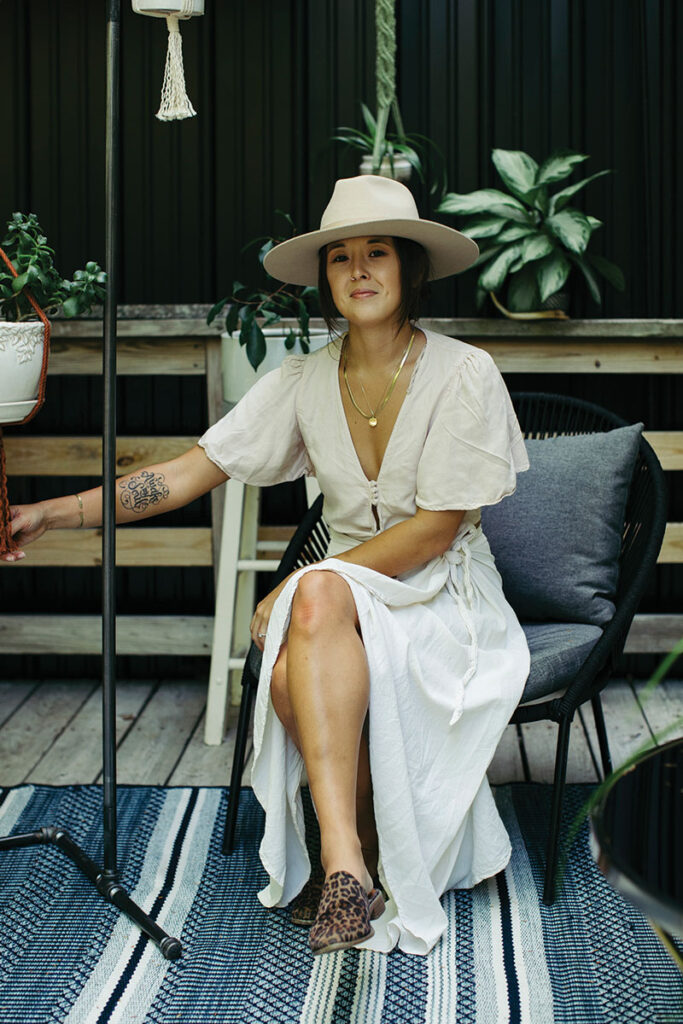Tucked away on a dirt road in the woods of Limerick, macramé artist Christina Hill’s beige Cape is nevertheless easy to spot: an elaborate knotted-rope wreath pops against the ebony front door, and a giant wooden arbor, bearing a knotted-and-fringed-rope curtain as intricate as a spider’s web, frames the path from the driveway to the side yard. On warm days, this is where you might find Hill on her deck, tying the knobby plant hangers, curtains, and wall décor that fill her home and the product lines for her company, Chill (a clever eponym).
Derived from the Turkish makrama, which referred to the knotted fringe adorning 13th-century linens, macramé flourished here and in Europe during the Victorian era, then resurfaced — in groovy browns, golds, and olive greens — in the ’60s and ’70s. Hill, who is 28, caught the third wave in 2016, when contemporary macramé began showing up on Instagram and design blogs. She made a simple square-knot curtain for a doorless closet and was hooked. “I thought, no one’s doing this in Maine. I should do this.” She taught herself increasingly complex knots and patterns and launched her business later that year.
Born in Korea and raised in Vermont, Hill graduated from Portland’s Maine College of Art in 2014 with a degree in graphic design and started a job at Burgess Advertising & Marketing in Falmouth, where she’s now an art director. But she wanted her own creative outlet. “I’m a homebody, but I don’t want to be a homebody who isn’t productive,” says Hill, who, in addition to décor, crafts macramé earrings, clutches, and embellishments for denim jackets. “I found something where I can watch TV and, at the same time, make something beautiful.” Rather than try to intuit others’ preferences, “my process has been to make whatever I want and, from there, people will see what they want or get ideas [for custom orders].”
In late summer, most new pieces were earmarked for her upcoming wedding: a black ceremony backdrop whose central strings she and her fiancé, a bass angler, planned to tie in fisherman’s knots, colorful plant hangers for the tent, an ivory children’s tent, and a white denim jacket with macramé appliqué. “I’m glad to get married, but I’m also really excited about the decorating,” Hill says. “To showcase all my macramé — that’s going to be really fun.”
Tell us more Christina Hill
When did you know you wanted to pursue an arts career?

I’ve always been an artsy person. But I’m really thankful I went to a [vocational] program in high school, where I got to explore photography, graphic design, painting, and drawing and figure out what I wanted to do. When I learned that some of my fiancé’s friends were sent to [a similar program], not because they were interested in it, but because they weren’t good in school, it bummed me out. I feel like in high school you should be encouraged to figure out who you are.
Any advice for those starting out with macramé?
I use the Macramé Pattern Book, which has more than 70 knots and lots of projects. A plant hanger is pretty small and basic. I use three-strand cotton rope because it’s soft and sturdier than single-strand rope. They say your folded rope should be twice the length of your finished piece, but for big pieces, I do three times to make sure I don’t run out.
Where do you draw inspiration?
Instagram, Pinterest, this weird macramé book from the ’50s I just got. I try to put my own spin on things. For example, I saw a picture of a macramé denim jacket made in Korea, where I get a lot of inspiration — there are tons of macramé artists there — but I have created one with a rainbow design.
Do you ever run out of things to make?
No! I want to make a swing for our niece, a chair or hammock, a headboard. On my fiancé’s boat, if you jump off, there isn’t a way to climb back up, so I thought, I should totally make a macramé ladder.





